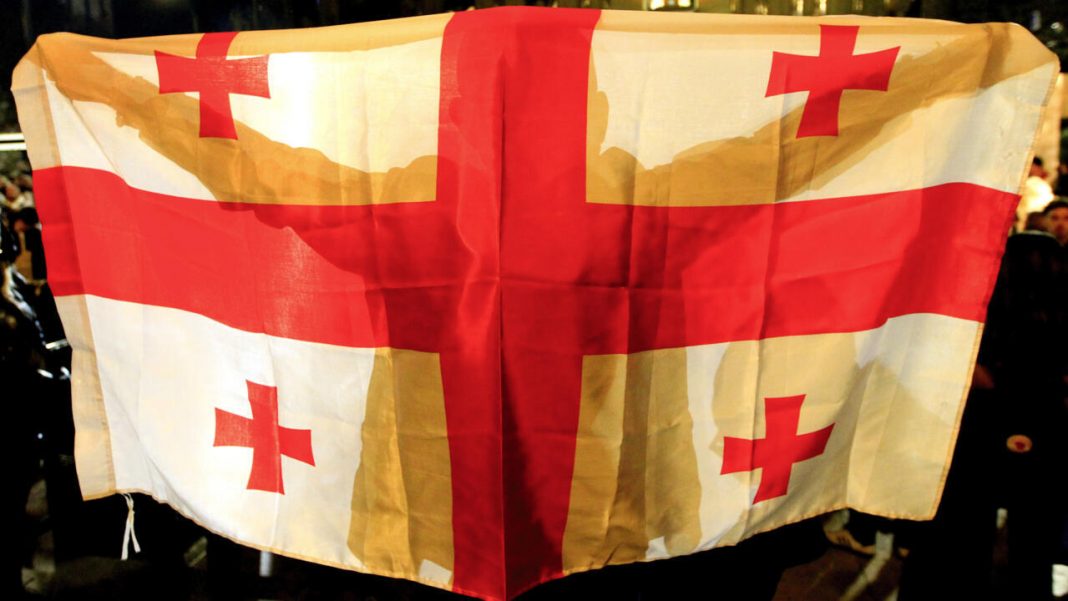The parliamentary elections that took place in Georgia on October 26, long before the voting day, were called fateful. The opposition was convinced that Georgians would have to choose “between Europe and Russia.” The ruling Georgian Dream party places the emphasis differently: the choice is “between peace and war,” which is supposedly inevitable if the pro-Western opposition wins. Moreover, “Dream” continues to position itself as a force that will lead Georgia to the European Union in 2030.
As a result of the parliamentary elections, Georgia split. After processing 100% of the protocols, the CEC announced the victory of the Georgian Dream, which received 53.9% of the votes, which guarantees it a majority in parliament, sufficient for the sole formation of the government, but not enough to change the Constitution. The four main opposition parties – Coalition for Change, which received 11.0% of the vote, United National Movement (10.2%), Strong Georgia (8.8%), and Gakharia for Georgia (7.8%), which received a total of 37.8% of the vote, did not recognize the election results, refused to give up their parliamentary mandates, and are preparing for a new battle with the government with the street as their main tool.
The opposition was joined by President Salome Zurabishvili, who has become not only the main consolidating center of the Georgian opposition, promoter of protests, but also an important link with Western partners.
In this piece Ascolta analyzes the results of the elections in Georgia, and examines the electoral mood and strategic tools of the political forces used in the campaign.
This Content Is Only For Subscribers
Did the “Dream” come true?
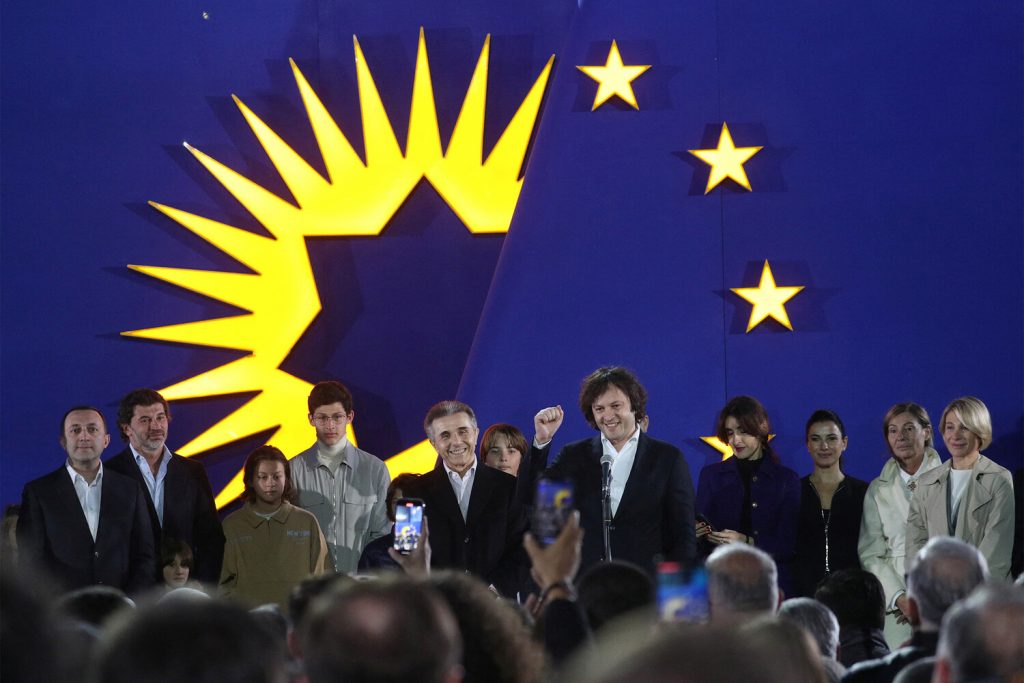
Elections to the Parliament of Georgia in 2024 were held for the first time only by proportional system. Prior to that, only 77 deputies were elected under the proportional system, and another 73 were elected in majority constituencies. In Georgia, the abolition of this practice has been sought for the last eight years. The fact is that single-mandate constituencies were usually of interest to influential local businessmen, who sought to belong exclusively to the ruling party, regardless of its name. As a result, to the seats won by the strongest party under the proportional system, almost as many mandates of majoritarian deputies were added. This is how the Georgian Dream’s party rating, which did not even reach 50%, always turned into a constitutional majority.
Moreover, this is the first electronic election in Georgia, where about 90% of voters cast their ballots using a special machine, i.e. the ballots were not processed manually. The seats in the supreme legislative unicameral body (there are 150 in total) must be distributed among parties that pass the 5% threshold. If no one won a majority, the parties would have to form a coalition government, which is what the opposition, divided among several political forces, had hoped for.
Despite the fact that 18 party alliances took part in the elections, the main struggle was between parties that were existentially opposed: the Georgian Dream and four opposition forces: “Unity – National Movement” (which includes the former ruling party ‘United National Movement’ founded by former President Mikheil Saakashvili), ‘Coalition for Change’, ‘Strong Georgia’ and ‘Gakharia – for Georgia’.
The Georgian Dream party, founded by billionaire Bidzina Ivanishvili, has been in power for 12 years; no one has ruled for that long in the history of independent Georgia. This year Ivanishvili returned to politics once again, personally headed the party list of Georgian Dream (this was the case only in the 2012 elections), and since August he has been actively involved in the election campaign. The billionaire together with the top officials of the ruling party “traveled” through all regions of Georgia. The tactics of the Georgian Dream campaign differed strikingly from the opposition.
“Dream” staked on live communication with people – work ‘on the ground’, organizing hundreds of meetings, dozens of concerts, in the process, like the ruling party, solving such infrastructural problems of residents as roads, as well as other issues of housing and communal services. While the opposition preferred advertising on social networks and talk shows in cozy TV studios, concentrating on large-scale problems and the geopolitical component of the elections.
Dream set maximum goals for the elections – a convincing victory and winning a constitutional majority. The ruling party cited several reasons why this is important for the country. The first, is the recovery of the political system” and the elimination of Saakashvili’s party, the United National Movement (UNM). “Immediately after obtaining a constitutional majority, we will initiate a legal process whereby the United National Movement and all its satellites or successors will be recognized as unconstitutional,” the party said in a statement.
In addition, Georgian Dream believes that the elections should be a “Nuremberg political verdict” for the UNM. After that, the authorities promise to create a “new opposition” with which it will be possible to communicate constructively. Such pleasant communication “Dream” is ready to continue for a long time: in recent discussions, the idea was mentioned that 12 years is not enough time to put the country on its feet. Perhaps it will take at least twelve more.
Another front is the fight against “LGBT propaganda”. The relevant law was passed in the first reading and should become part of the Constitution. By the way, the adoption of the law “On Protection of Family Values and Minors” and another high-profile law “On Transparency of Foreign Influence” (also known as the “law on foreign agents”), which were dubbed Russian laws, caused protests of the pro-European part of the Georgian population.
These laws, adopted after Georgia was granted the status of an official candidate for EU accession in December 2023, were heavily criticized in the EU and Georgia’s EU accession process was “effectively suspended.” The EU ambassador allowed the revision of the visa-free regime for Georgian citizens. In addition, Brussels froze €30 million allocated for the Georgian Defense Ministry, while the US authorities imposed visa sanctions on dozens of Georgian officials and suspended more than $95 million in aid to Georgia.
For the first time in a decade, the UK decided to freeze the Wardrop Dialogue with Georgia at the ministerial level and cancel talks between the countries’ defense headquarters. British Ambassador to Georgia Gareth Ward explained that the development of recent political events in Georgia first worried, then disappointed and then shocked the British side. The Georgian Parliament adopted the law “On Transparency of Foreign Influence”, “limiting the activities of civil society”, and the leaders of the Georgian Dream began to engage in, in the Ambassador’s opinion, anti-Western propaganda.
However, despite deteriorating relations with the West Bidzina Ivanishvili promised that Georgia will become a member of the European Union in 2030. “Today Georgia is the leader among the candidate countries for EU membership by all indicators. Our economy is growing faster than all these countries. I promise that we will overcome all difficulties, strengthen sovereignty, preserve peace, develop the economy and in 2030 we will become a member of the European Union,” Ivanishvili said.
Georgian Prime Minister Irakli Kobakhidze echoed him, saying that the Georgian Dream has no plans to remove the article on EU and NATO integration from the country’s Constitution. On the contrary, European integration remains Tbilisi’s external priority, and according to Kobakhidze, Georgia plans to join the European Union by 2030, together with Abkhazia and South Ossetia.
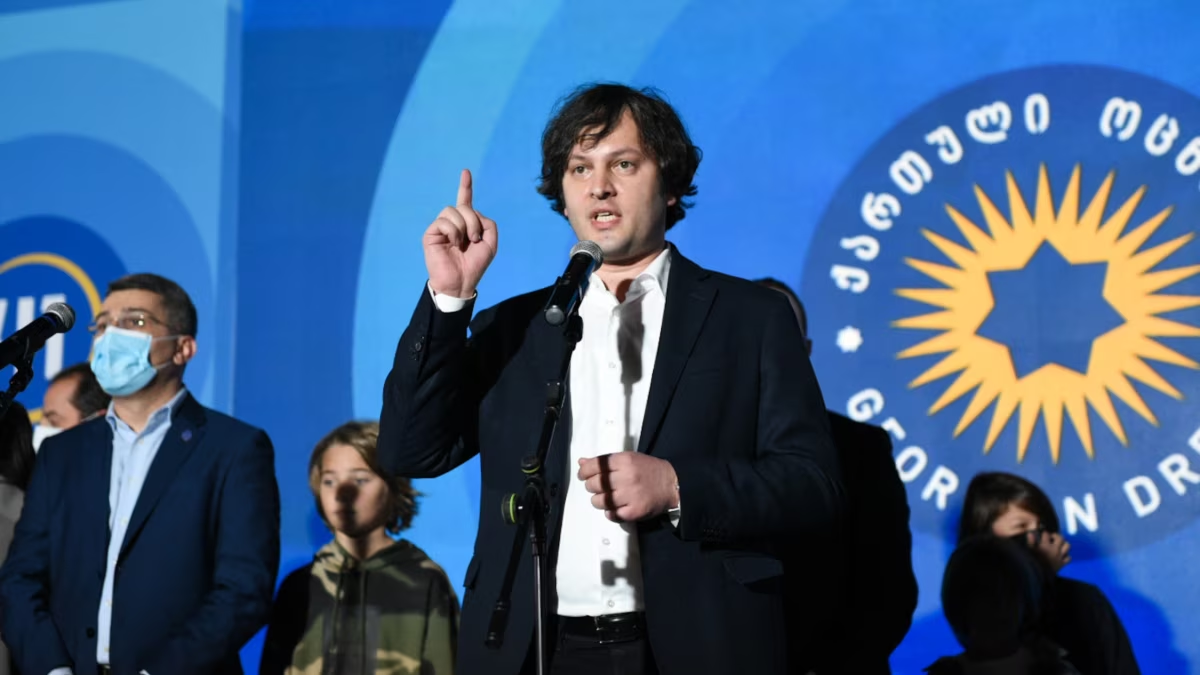
And to the accusations pouring from the West in a flood of accusations of abandoning democracy and attempts to establish authoritarianism “Dream” responds that the West is trying to drag Georgia into a war against Russia, as well as to organize a revolution in the country to change the government. According to Bidzina Ivanishvili, relations with the West will improve as soon as the war in Ukraine is over, which may happen very soon. Until that happens, Tbilisi will be forced to defend its interests and avoid confrontation with Moscow, even if relations with Europe suffer.
The choice between “war and peace” became the election “trick” of the Georgian Dream campaign. In his pre-election statements, the party founder urges voters to choose between “peace and war” – Ivanishvili blamed the probability of the latter on a certain “global war party”, which, according to him, influences the EU and NATO and seeks to bring the opposition to power in order to open a “second front” against Russia in Georgia.
Earlier, Bidzina Ivanishvili claimed that an unnamed high-ranking foreign official suggested that former Georgian Prime Minister Irakli Garibashvili start a war with Russia and then “go into the forests with a guerrilla movement.” According to him, the Georgian Prime Minister asked how long the interlocutor thought Georgia would be able to hold out in such a situation, to which he received an answer: three or four days. Then he asked if it was really worth destroying Georgians for the sake of three or four days, the answer in Ivanishvili’s paraphrase was as follows: “There are 3 million of you, and they will not be able to kill you all in three or four days. Then you can go into the forests with the guerrilla movement and we will help you”. Ivanishvili did not name the name, position of the foreign official or the country he belongs to.
The theme of “war and peace” was also reflected in the advertising campaign of the Georgian Dream, though with a scandalous tinge. It was about pre-election banners and videos of the ruling party, which depicted rebuilt buildings in Georgia under the slogan “Choose Peace” in contrast to the images of war-stricken cities of Ukraine. It is worth noting that against the backdrop of deteriorating relations with the West, it has become important for many people in Georgia to preserve peace with Russia, which directly borders Georgia. The narrative fork “war or peace” turned out to be much wider and deeper in scope than the choice offered by the opposition – EU or Russia. Therefore, there were many supporters of Georgia’s European integration among those who voted for the Georgian Dream. And the attempt to explain the motive of voters to vote for “Dream” only by bribery and intimidation does not look convincing.
Another central theme of Ivanishvili’s election speeches is the issue of Georgia’s territorial integrity and the promise to punish the “instigators of the war” of 2008. “After the parliamentary elections and the Georgian “Nuremberg process”, the Georgian authorities will find the strength to apologize to their Ossetian brothers and sisters for the actions of the United National Movement,” Ivanishvili said at a campaign rally in Gori. And Georgian Prime Minister Irakli Kobakhidze, speaking at the 79th session of the UN General Assembly, addressed the residents of Abkhazia and South Ossetia and said the Georgian government would always welcome citizens “on this side of the line.” “Despite the fact that 20% of our territory is illegally occupied, we continue to move forward, grow and work to ensure that our children live in a better, stronger and more dignified Georgia.”
Kobakhidze said the authorities hope to “rebuild all the destroyed bridges” between Georgia, Abkhazia and South Ossetia and return them to Georgia by 2030. He called such a move a “Georgian dream.”
Presenting the election program of the Georgian Dream, Georgian Prime Minister Irakli Kobakhidze said that the main priorities for the republic are restarting relations with the West, deepening cooperation with NATO and China, pragmatic policy and peaceful settlement of the conflict with Russia. Even based on the main postulates of the election program of the Georgian Dream, it is difficult to call it a pro-Russian political force, as the opposition constantly reproached them with. This was rather a political-technological technique that was widely used by the opposition. All sociological surveys showed that 70-80% of the Georgian population was stable and supported the country’s movement towards Europe. Therefore, it was important for the opposition to present “Dream” as a pro-Russian force in order to put the voters in front of a choice: either to Europe or to Russia.
This technique is used quite often in post-Soviet countries. We saw a similar practice in the Moldovan presidential election, where the authorities tried to make the second-place former prosecutor Alexandru Stoianoglo a pro-Russian candidate and put the voter before the same choice: Europe or Russia. This did not work in Moldova, and in Georgia, by and large, it did not work either. “Dream” positioned itself as a sovereigntist party, which is not oriented towards external players, but towards the national interest. Hence its diverse vectors rather than adherence to a single line. “Georgian Dream” is trying to establish political stability in the center, i.e. in its own country, and not to be oriented to the flanks, where the EU and NATO are on one side and Russia on the other.
Suffice it to recall that no one in the Georgian Dream is advocating the restoration of diplomatic relations with Russia, but is exponentially developing its relations with China, Turkey, Azerbaijan, Iran and a number of other countries of the Global South. As all Central Asian countries are interested in developing new routes, transit for Georgia is of key importance. With this in mind, there was a need to create new ports and modernize railroads.
Georgia is a natural bridge at the crossroads of Europe and Asia and a regional transportation hub. At the same time, Georgia does not want to join BRICS, but tries to maintain a balance in its relations with the collective West and the Global South. At the same time, the analysis of geopolitical processes makes it clear that China is much more interested in the systemic formation of more conservative views in Georgia than Russia. Few people pay attention to the increased influence of Beijing on political and economic processes in Georgia, which in the future allows China to become an important player in the Black Sea region. At the same time, behind the screen of Russia, which is allegedly actively influencing Georgia’s turn away from Europe, Beijing seems to be absolutely comfortable or even profitable.
As for Russia, in this case – as they say – “nothing personal, only business”. It is simply profitable for Georgia to trade with Moscow. It is a capacious sales market. Georgia sells Georgian wines and soft drinks to Russia, gets good income from tourism, and imports energy carriers – oil, gas and electricity. Georgia makes good money on Russia. And since it is so, it is profitable for the authorities.
And what about the opposition?
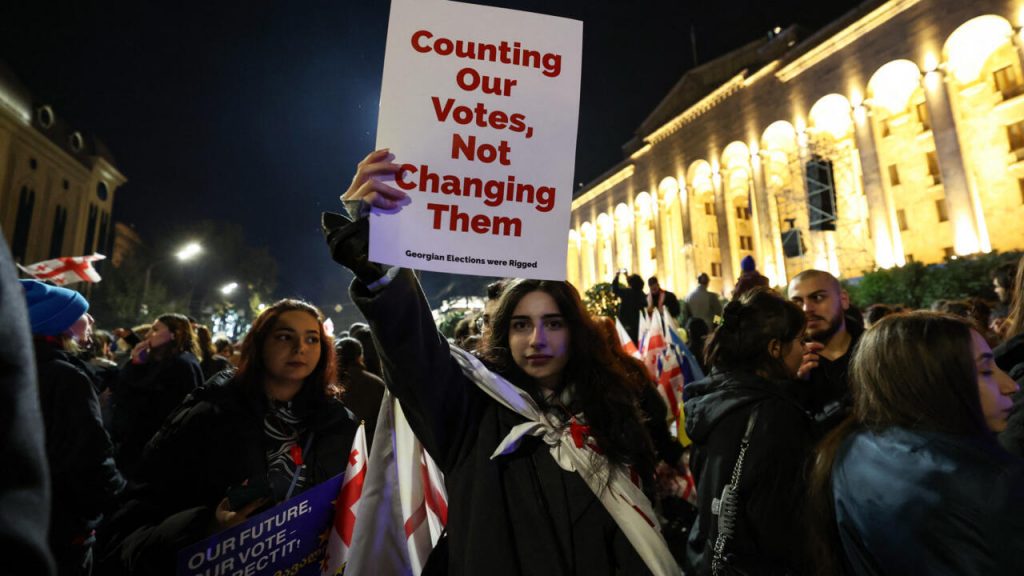
It is worth noting that the main political outcome of this parliamentary campaign for the opposition was the loss of the monopoly of the United National Movement (UNM) – the former ruling party founded by the third president of Georgia Mikheil Saakashvili. Judging by the election results, whether they were based on Edison Research exit polls – 16.7% or the Central Election Commission – 10.2%, Saakashvili’s party, accustomed to its longstanding dominance” on the opposition flank and operating strictly in the bipolar model of ‘dreamers vs. nationalists,’ was surprised to find that it had about the same result as the other three unions, thus turning from ‘the main opposition party’ into ”one of the opposition parties.
Although the United National Movement did not go to the elections alone, but in the company of its allies Agmashenebeli Strategy and European Georgia, which formed the Unity – National Movement coalition, this did not automatically lead to an increase in the number of votes for Saakashvili’s alliance. It should be recalled that in the 2020 parliamentary elections, without the Agmashenebeli Strategy and European Georgia, the National Movement received 27.18%.
The Unity – National Movement election campaign was not very creative. The election program contained only five points: accession to the EU; income growth; protection of pensioners; strengthening of the Georgian family: childbirth allowance for all needy families; victory over the “price mafia”, which meant restoration of competitive market conditions by fighting against “business monopolies” cultivated by the state.
Unity also promised to raise 14 billion euros for Georgia’s “European welfare” and to create a “Saakashvili fund” for the return of emigrants. One of the most important tasks of the coalition was to release its leader, Mikheil Saakashvili, from prison. It is likely that such arguments were not enough to repeat the 2020 result, let alone increase it. And it looked quite predictable.
In the last twelve years, the party has endured permanent internal struggles, splits, chairmen leaving and returning, and even a drop in its rating to 7%. Its former leaders from the Akhali party, who formed the Coalition for Change, appear to have managed to attract a significant portion of the “mother party” voters, unlike the unsuccessful European Georgia, founded after the 2017 split. The “Lelo” party, the leader of the “Strong Georgia” coalition, got its share of electoral spoils from the “UNM inheritance”.
“Dream” could hardly claim the votes of its irreconcilable opponents, but it actively poached former UNM coordinators in the regions and must have benefited from it. The decline of the National Movement led to the most significant structural changes on the opposition flank during the entire period of Georgian Dream’s rule. Of course, it cannot be said that Mikheil Saakashvili left the forefront, but other equally ambitious competitors appeared next to him.
One of these players is the Coalition for Change, which according to the CEC data gained 11% of the vote and according to the Edison Research exit poll – 16.7%. The first violin in the “Coalition for Change” was played by the party “Akhali” (“New”), headed by the duo of Niki Melia and Niki Gvaramia.
Melia left the National Movement in December 2023, shortly after he was ousted as party chairman for his apparent lack of loyalty to Saakashvili. Before that, in 2001, he served four months in prison after being charged in a case “for organizing and participating in group violence on June 20-21, 2019.” The investigation found that he had called for riots on Rustaveli Avenue after “Gavrilov’s Night.” Melia was chairman of the UNM when Russian MP Sergei Gavrilov’s visit to Georgia’s parliament sparked public outrage, a spontaneous rally and clashes between protesters and police. Melia’s arrest took place six months after the events of “Gavrilov’s night”, and to take him to the police, special forces had to storm the party office building where opposition supporters had fortified themselves. The court released Melia from pre-trial detention after the bail was paid by the European Union – the oppositionist himself refused to do so on principle, but European officials at that time were trying to mitigate political polarization in Georgia.
The second leader Niki Gvaramia was also brought to criminal responsibility. In 2022 he was sentenced to 3 years and 6 months of imprisonment for “abuse of official powers” in the position of General Director of a private TV company. This was almost immediately after he started the Mtavari TV company. An extreme measure under the administrative article was applied to him, although there were no victims in the case. The scandal affected the process of European integration: European leaders came to Gvaramia’s defense. As a result, Gvaramia, who served a year and two months in prison, was pardoned by the President of Georgia. To Gvaramia’s record we can add that at the age of 27 he became a member of parliament from the “Nationals”, and then served in the government as Minister of Justice, Deputy Prosecutor General and Minister of Education.
Also included in the coalition is the “Droa!” party, led by Elene Khoshtaria, another former UNM representative, who formed her own party in early 2021 after the European Georgia party, which split from the UNM, turned its back on her. “Droa!” means ‘the time has come!’ in Georgian. It holds strong anti-Russian positions and has become attractive to urban liberal voters.
Another political force that joined the coalition was the libertarian party “Girchi – More Freedom.” Zurab Girchi Japaridze became the undisputed leader of his own party after disagreements with other leaders of the original Girchi party in late 2020. Japaridze’s group was the first to break away from the UNM in 2016. Since then, the former UNM official and MP has become less likely to wear a tie, started actively using social media and attracting a relatively stable audience of young voters through unconventional political stunts and advocating liberalization of the fight against drugs.
After Niki Gvaramia’s unexpected announcement that he would not be included in the party’s electoral list, the coalition presented as its main candidate Nana Malashkhia – an employee of the Tbilisi City Hall, an active participant of protests against the “law on foreign agents”, who became world famous as “the woman with the EU flag against water cannons”.
To summarize their election program, the “coalitionists” promised voters systemic changes and a “big reset” with the main focus on EU accession. The symbolism of the bloc was the number four – because of the coalition’s number four on the ballot and their “4-4-4 plan”. The coalition promised to present the most important change initiatives in four areas four days after the formation of the coalition government (in case of victory): resuming European integration processes, initiating democratization processes, reducing taxes, and reforming education.
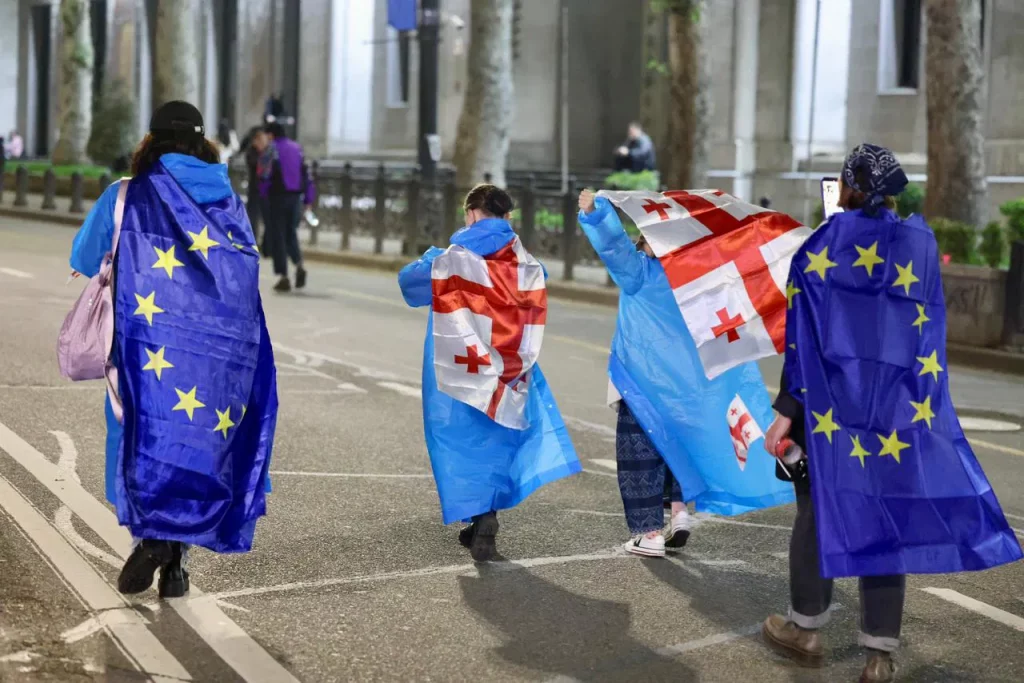
The third opposition force was the project “Strong Georgia”, which according to the data of the Georgian Central Election Commission gained 8.8%, and according to independent exit polls – 10.3%. It included the parties “Lelo”, “For the People” of Anna Dolidze, “Citizens” of MP Aleko Elisashvili and the public-political platform “Freedom Square” of Levan Tsutskiridze. The “Lelo” party became the base political force of the project. Its leader is 57-year-old Mamuka Khazaradze, a graduate of Harvard Business School and founder of TVS, one of the largest commercial banks in Georgia.
And while he started working in the financial sector back in the 90s, and successfully brought the bank to the London Stock Exchange, he found himself in politics only after his business problems began. In 2019, the Georgian government suspended a consortium established with the participation of TBC Holding from the construction of the Anaklia deep-water port in the west of the country. The consortium was going to implement the Georgian “project of the century” together with American partners, but this summer the authorities gave the “project of the century” to a Chinese investor.
In mid-2021, Anna Dolidze founded the For the People party, focusing on issues such as judicial reform and the fight against political corruption. She is a former deputy defense minister and human rights activist. She has criticized both the United National Movement and the governments led by Georgian Dream. And these criticisms of both major political parties have made her teflon to accusations by Georgian Dream critics that she is in alliance with the National Movement. Experts say Dolidze’s party is part of Georgia’s left-wing political spectrum, which is struggling to grow.
Another member of the alliance is the public-political platform “Freedom Square” – the brainchild of Levan Tsutskiridze, former head of the East European Center for Multiparty Democracy. After co-leading the anti-government protests against the Foreign Agents Law, he organized the Freedom Square rally in July to mobilize other leaders like himself – those with no previous political experience – to enter the political arena.
“Citizens” is a project that is entirely associated with former journalist and civic activist Aleko Elisashvili, known for his angry and denunciatory speeches against the current government. Elisashvili has achieved considerable influence, coming second in the Tbilisi mayoral elections seven years ago, beating the National Movement candidate. However, he failed to capitalize on this success and only formed his own party in 2020.
“Strong Georgia” promised voters, in addition to EU accession, Georgia’s accession to anti-Russian sanctions, a set of populist slogans – the creation of 200,000 jobs, a pension of 1,000 GEL (330 euros) and restrictions for Russian citizens: the ability to buy land, a ban on participation in state tenders, and the introduction of an ‘occupation fee’ for Russian businesses.
The fourth opposition force to enter parliament was the Gakharia for Georgia party, which won 8% according to exit polls and 7.76% according to the CEC. Even before the start of the election campaign 49-year-old Gakharia was called the most dangerous rival of the incumbent government.
Even the opposition recognized that while the UNM and Akhali were basically targeting the same segment of voters, Gakharia was siphoning off the votes of Georgian Dream supporters who were disappointed with Ivanishvili’s policies. A political science graduate of Moscow State University and a successful CIS and Russia manager for Lufthansa, Gakharia has worked in the Georgian Dream government for more than six years. In the opposition, he was given the offensive nickname “vyreviglaz” after the “Gavrilov Night” protest in 2019. Gakharia was head of the Interior Ministry at the time and was accused of violently dispersing the rally and causing several people to lose their eyesight and injuring more than 200 demonstrators and journalists with rubber bullets. Despite the protests, Gakharia was not resigned but was made prime minister. In this position, he mainly had to deal with the pandemic.
Many believe that Georgia had excellent relations with the United States during Gakharia’s premiership. His success in the premiership was evidenced by the fact that he was at the head of the Georgian Dream electoral list in the 2020 parliamentary elections. He resigned after stating that he did not agree with the methods of arresting UNM leader Niki Melia, i.e. storming the opposition party’s office building. After resigning he founded his own party “For Georgia”. At that time he was the second most popular person in the country after Catholicos Ilia II. However, the campaign organized by Ivanishvili quickly destroyed the influence of the former prime minister. Nevertheless, Gakharia did not give up and began to build a party strategy that positioned the party of the former Prime Minister as a third force that was in great demand in Georgian politics. While most of the opposition parties were trying to build coalition configurations, Gerogi Gakharia defiantly announced that For Georgia was not planning to unite with any political party for electoral purposes. President Zurabishvili proposed to unite Gakharia’s party with the “Strong Georgia” bloc. Sociologists predicted that they would get 25% of the votes when forming a coalition. However, the negotiations that started shortly before the elections were not successful.
Gakharia found his electoral niche and those who did not want to vote for either Georgian Dream or National Movement voted for his party. The threat to the Georgian Dream from the Gakharia for Georgia party is evident at least from the fact that billionaire Bidzin Ivanishvili switched from criticizing the Nationals to the former Prime Minister, calling him an “agent” and a “scumbag” and promised to put him and his party members on trial.
Even before the start of the election campaign, the issue of uniting the opposition forces and forming a single list was widely discussed. Many experts believed that by refusing to unite under a single number the opposition, in fact, refused to make these elections a referendum for or against the European future of the country and lost the votes of those voters who did not want to affiliate themselves with a particular party. However, in our opinion, this approach looks superficial, for it reduces the problem to the solution of an algebraic equation in which the maximum coverage of the opposition electorate gives the parties that pass the 5 percent threshold as many votes as possible. But it is often forgotten that political leaders are not X’s and Y’s, obedient to their will, but ordinary people with their own interests, hopes, fears, colossal ambitions, and it is inherent in them to make mistakes.
The only one in favor of a unified list was former President Mikheil Saakashvili: “I call for unity. We are ready to make any concessions – a neutral number, a common list”. Many party leaders took this proposal without enthusiasm. Thus, the leader of “Lelo” Mamuka Khazaradze said: “I do not agree with the unified opposition list, I agree with the idea of an alternative center. We must give the voter an alternative platform and center… It will be a center without the National Movement”. In its turn, the National Movement, promoting the idea of a single list, probably saw not only an opportunity to consolidate additional votes, but also to neutralize the inevitable criticism of rival oppositionists during the pre-election period.
However, Saakashvili remained in the minority, and the opposition went to the elections in different columns, choosing the option of creating large party unions, which was favorable to the parties that had prerequisites for overcoming the five-percent barrier and expanding their electoral base. All four opposition alliances signed President Salome Zurabishvili’s proposed “Georgian Charter” – a post-election action plan that includes urgent reforms and Georgia’s return to the path of European integration. The “Georgian Charter” looked like an attempt to gather all major opposition figures under one symbolic flag as a united pro-European opposition. In practice, it did not impose any obligations on the participants, but turned the elections, according to Zurabishvili’s idea, into a kind of referendum where people choose between pro-European opposition parties or the pro-Russian Georgian Dream.
Joy and shock
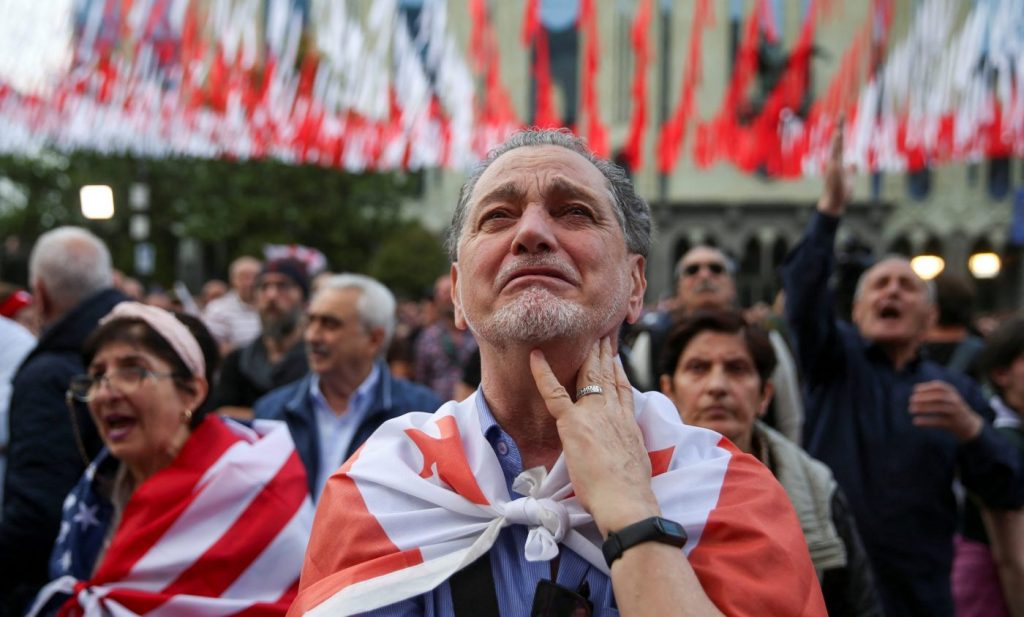
58.94% of voters came to the elections, which all sides called momentous, slightly more than in 2020 (56.11%) and slightly less than in 2012 (60.08%).
After the CEC began announcing the first election results, the opposition was shocked by the discrepancy between the always accurate exit poll predictions of the American sociological company Edison Research and the official figures. Edison has been conducting research on all elections in Georgia for the last six years and the differences with the CEC data were consistently within the margin of error, i.e. 1-2%. Therefore, when Edison showed that “Dream” got 41% and the opposition 51.9%, it definitely meant a victory for the opposition. The difference of 10% also allowed to consider that one could not be afraid of falsification by the authorities, because, as the opposition assumed, in the conditions of electronic voting such cases would amount to maximum 5%. At the same time with the opposition the Georgian Dream started celebrating the victory – again before any news from the Central Election Commission. The pro-government TV channel Imedi published the results of its exit poll conducted by the local sociological service Gorbi, according to which the party of billionaire Bidzina Ivanishvili gained more than 56% of votes. The first data from the CEC showed approximately the same figures.
It took the opposition about an hour to react to the news of the defeat. Gakharia’s party said that they will wait for the final results, but as one of its leaders Natia Mezvrishvili put it, they will not wait for them “idly”. Lelo – Strong Georgia, the National Movement and the Coalition for Change said that the elections were stolen and that they know how the government was able to rig the results – by using a scheme where the same person with a false ID could vote several times at different polling stations. By the morning of October 27, all four opposition forces declared their non-recognition of the election results and promised to organize mass protests, but for some reason did not take their supporters to the streets that day.
Local observers also point to the fact that in all major self-governing cities – Tbilisi, Kutaisi, Rustavi, Batumi, and Tsalenjikha – the opposition won with a big advantage. “Georgian Dream” won more than 70% of votes in such regions as Gardabani, Marneuli, Bolnisi, Dmanisi, Akhalkalaki, Ninotsminda, where traditionally the majority of the local population does not speak Georgian and is under great pressure from the ruling force. The opposition made it clear that it would try to raise a “revolutionary wave” only if the OSCE and PACE observers recognized the elections as “unfree and unfair”. This was probably due to the unwillingness to repeat the scenario of 2020, when the opposition announced a boycott of parliament, publicly renouncing mandates, but under pressure from Western partners took back its words.
Meanwhile, observers’ assessments were quite contradictory. On the one hand, they all agreed that the electoral process in Georgia was, to put it mildly, not perfect. There were reports of ballot stuffing, pressure and bribery of voters, and the participation of commission members in agitation. On the other hand, the OSCE in its press release gave a rather restrained assessment of the elections. Noting that the voting took place in the conditions of severe polarization of society and the entry into force of the law “on foreign agents”, as well as against the background of pressure on voters, the organization stressed the presence of a wide choice among the parties represented in the ballots, as well as the possibility of free campaigning. Pascal Alizar, Special Coordinator of the OSCE observation mission, even expressed hope that “the elected leadership will effectively address the main challenges, bringing Georgia closer to its EU membership goals”.
The post-election landscape
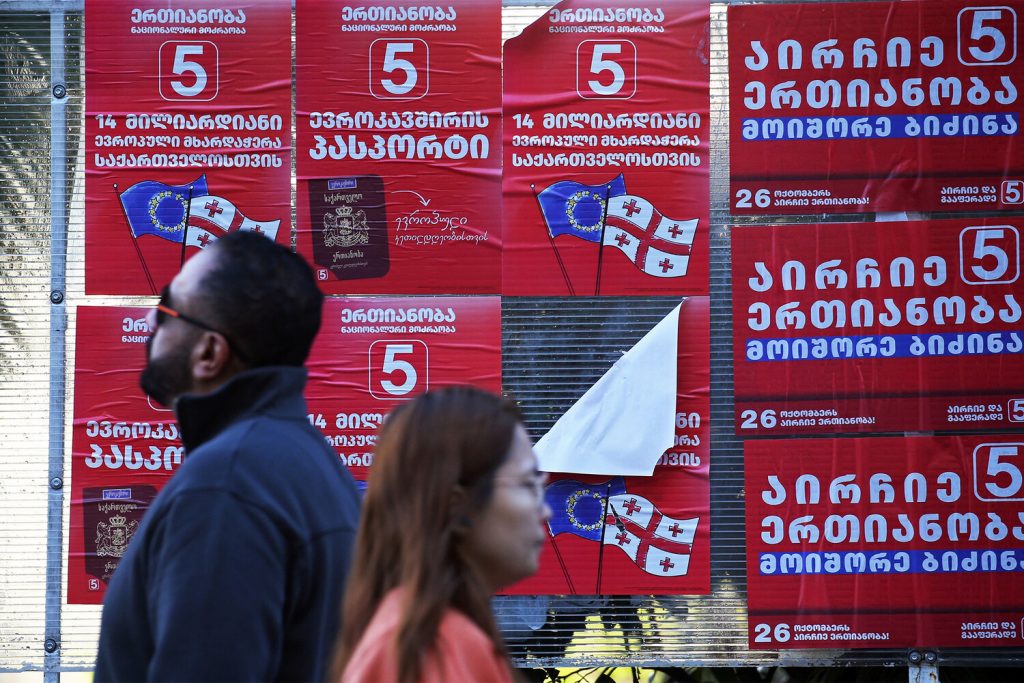
After the CEC finished counting the votes at the polling stations, the balance of power in the new Georgian parliament became clear. “Georgian Dream” won 89 mandates, while the opposition won 61. “Coalition for Change” – 18 mandates, ‘Unity – National Movement’ – 17, ‘Strong Georgia’ – 14. And the party “Gakharia for Georgia” – 12 mandates.
However, all four opposition parties that were elected to the Parliament refused to recognize the results of the elections and to take part in the work of the 11th Parliament. Georgian President Solome Zarubishvili actively joined the process and managed to consolidate the opposition around her. The support of the President added institutional weight to the opposition’s non-recognition of the election results, but not for long. Zurabishvili’s term expires this year, and the next president – due to the 2017 constitutional reform – will be elected not by popular vote, but by an electoral college consisting of members of parliament and delegates from the regions. In all likelihood, the Georgian Dream, which supported Zurabishvili in the elections several years ago, will be able to field a different candidate this time around. Nevertheless, the opposition had its own reason to stick with the president. Despite her ceremonial functions, Zarubishvili, according to the Basic Law, has the right to convene the first session of the newly elected parliament. If the President does not use this prerogative, then, according to the opposition, the legislative body, even if the GM deputies convene on their own, will not be authorized to make decisions.
At her press conference with representatives of the opposition forces, Zurabishvili called the country’s government “illegitimate”, which let Russia into Georgia by rigging the elections. She stressed that she would not recognize the October 26, 2024 parliamentary elections. Zurabishvili called on the international community to stand with the Georgian society and politicians who fought the elections and will continue to fight for Georgia’s European future, and called for protests. The next day, a rally of thousands of supporters of the Georgian opposition took place in Tbilisi, demanding that the results of the parliamentary elections be canceled due to the facts of mass falsification. Many considered it the start of indefinite protests. However, having put forward a demand that new elections be held under the control of the international election administration and not the current corrupt Central Election Commission, the opposition went home. There was a political pause and a new strategy of the Georgian opposition began to emerge – the European Union and the United States should investigate all the circumstances of the parliamentary elections in Georgia, and even better – organize re-elections under their auspices. These are the options that the opposition in Tbilisi is inclined to Western leaders.
However, questions immediately arose. Thus, according to the law (Article 127 of the Election Code of Georgia) re-elections to the parliament are possible in two cases: the elections were declared invalid and the elections were declared valid, but none of the parties could not overcome the 5% threshold. So there are no grounds for re-elections for the time being. Theoretically, they can be held, but only in case of mutual agreement between the authorities and the opposition. However, such a consensus is still impossible. Moreover, if Georgian Dream goes for re-election, it will hit the party itself. Its voters may consider such a step as weakness and not come to the elections. And then the re-election will be a victory for the opposition. However, this scenario seems unlikely.
Another scenario of the opposition, which should prompt the Georgian government to investigate all the facts of violation of the law during the elections, is already working. Thus, the head of European diplomacy Josep Borrell called a meeting of the EU’s political and security committee on October 29. “I have asked the committee to meet today to urgently discuss the difficult situation in Georgia. I have also put this issue on the agenda of the November meeting of the EU Foreign Affairs Council,” he said in a statement. The top European diplomat emphasized the importance that “the protests and the government’s response to them remain peaceful”.
Meanwhile, on the other side of the Atlantic, U.S. State Department spokesman Matthew Miller told a briefing that the U.S. was consulting with European colleagues on how and who could most effectively investigate what happened during the Georgian elections. Then the “heavy artillery” joined the process. The White House website posted a statement by U.S. President Joe Biden, in which the American leader emphasized the need for a thorough, transparent investigation into the facts of fraud during the October 26 parliamentary elections in Georgia and called on the authorities to immediately begin a dialogue with the opposition forces “to restore the integrity of the elections”. In addition, Biden appealed to the Georgian government to repeal the so-called “Law on Foreign Influence,” which restrict freedom of assembly and expression.
Secretary General of the Georgian Dream party and Tbilisi Mayor Kakha Kaladze reacted to Biden’s statement. “Joe Biden cannot assess the elections or whether the government is legitimate or not. It is the OSCE that makes these assessments. We heard their interim report, which was just amazing, I don’t remember such a report after the end of the elections. They spoke directly and said that the elections were competitive, multi-party. As far as the allegations of fraud, that’s what the investigation was for, to make sure that everything is answered. There should be no question marks left, we will give everyone the opportunity to count everything. I am convinced of our rightness,” Kaladze stated.
The Prosecutor’s Office of Georgia at the request of the CEC has launched an investigation on the article of election fraud and promised to study all the facts voiced by the President, parties, observers and to interrogate everyone who may have information about fraud. President of Georgia Solome Zurabishvili should be the first to go to the Prosecutor’s Office to testify. However, the President of Georgia said that she will not go to the prosecutor’s office. “I would advise the prosecutor’s office to do its job and avoid political settling of accounts with the president,” Solome Zurabishvili said.
It must be said that Western officials, despite the general rhetoric of concern over reports of election fraud, have behaved very cautiously and refrained from calling for a boycott of the election results. European Council President Charles Michel called for a swift and transparent investigation into alleged election irregularities the day after the vote. The West has not made the Georgian elections the centerpiece of its foreign policy narrative. There are presidential elections in the United States, and “old Europe” also has a lot of problems. And powerful pressure on the Georgian government may push it into other geopolitical embrace. It should be reminded that the Georgian Dream was congratulated on its victory by Viktor Orban, who has already visited Tbilisi and personally paid his respects, Azerbaijan, Armenia, Turkey and the United Arab Emirates. Russia did not congratulate the Georgian Dream on its victory, calling the results “the choice of the Georgian people” and “strongly rejected” accusations against Russia of interference in the internal processes in that country. China, on the other hand, opted for neutral rhetoric. “China has always respected the choice of the Georgian people and sincerely wishes Georgia stability and prosperity. China is ready to work with all sides to promote the continuous development of China-Georgia relations,” said Chinese Foreign Ministry spokesman Lin Jian.
Probably, feeling that the West is not in a hurry to make far-reaching conclusions about the Georgian authorities, the opposition is concentrating on gathering evidence of election fraud and is not forcing events, waiting for a favorable moment. So far it is not commenting on its plans, probably counting on subsequent actions of the authorities. And the most convenient moment for it may be the first session of the new parliament.
According to the CEC, Georgian Dream has 89 mandates out of 150. However, Article 38 of the Constitution of Georgia states: “The Parliament acquires full powers from the moment when two thirds of the members of the Parliament (i.e. 100 people) recognize the powers of the Parliament. The powers of the Parliament of the previous convocation shall be terminated from that moment”. The opposition has already promised that they will give up their mandates, hence the newly elected parliament does not receive powers. “The Georgian Dream is 11 mandates short. However, Ivanishvili may “buy” the missing deputies from the opposition. This is the opinion of many Georgian experts familiar with local political realities. However, according to Georgian expert Vakhushti Menabde in his commentary to BBC, a simple majority of 76 seats is enough for the parliament to work. And if the opposition refuses to participate in the sessions, there is no prohibition in Georgian law on the work of parliament, even if it is represented by one party. Speaker of the Georgian Parliament Shalva Papuashvili is also confident that the opposition will not prevent the newly elected MPs from gathering for the first session of the parliament. Despite the fact that Georgian President Solome Zarubishvili has refused to recognize the election results and has no plans to schedule the first parliamentary session, Papuashvili is confident that it does not matter and noted, “On the tenth day (after the official summing up of the election results) the parliament will be obliged to convene. Therefore, if she does not schedule a session, the parliament will still convene,” the politician assured.
According to most experts, this is the day when the protests should be expected to culminate. As former Mayor of Tbilisi Gigi Ugulava noted, the opposition forces “will block the parliament building and will not allow the deputies who stole votes from the people to enter it”. The experience of previous years showed that on the day of the session protesters lined up in live chains and blocked the entrance to the parliament. However, there is a weak link for the opposition. The parliament building has several entrances. As the BBC notes in its report, at least two of them open onto a side street where the Georgian State Security Service and Georgian Special Forces barracks are located. And if the situation escalates, the security forces could easily clear this street of protesters and create a safe corridor for the ruling party’s deputies to enter parliament. Moreover, during more than a decade of the Georgian Dream’s rule there have been protests in Tbilisi many times. Including after the elections. However, they could not shake the power of the “Dream”.
The authorities responded by using force when the opposition tried to break into government buildings and parliament. And they did not make concessions. And the actions, since they had no effect, gradually came to naught.
How it will be this time, we will find out in the near future….

